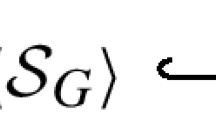Abstract
In the case of finite groups, a separating algebra is a subalgebra of the ring of invariants which separates the orbits. Although separating algebras are often better behaved than the ring of invariants, we show that many of the criteria which imply the ring of invariants is non-Cohen–Macaulay actually imply that no graded separating algebra is Cohen–Macaulay. For example, we show that, over a field of positive characteristic p, given sufficiently many copies of a faithful modular representation, no graded separating algebra is Cohen–Macaulay. Furthermore, we show that, for a p-group, the existence of a Cohen–Macaulay graded separating algebra implies the group is generated by bireections. Additionally, we give an example which shows that Cohen–Macaulay separating algebras can occur when the ring of invariants is not Cohen–Macaulay.
Similar content being viewed by others
References
D. J. Benson, Polynomial Invariants of Finite Groups, London Mathematical Society Lecture Note Series, Vol. 190, Cambridge University Press, Cambridge, 1993.
D. J. Benson, Representations and Cohomology. I, Basic Representation Theory of Finite Groups and Associative Algebras, Cambridge Studies in Advanced Mathematics, Vol. 30, 2nd ed., Cambridge University Press, Cambridge, 1998.
D. J. Benson, Representations and Cohomology. II, Cohomology of Groups and Modules, Cambridge Studies in Advanced Mathematics, Vol. 31, 2nd ed., Cambridge University Press, Cambridge, 1998.
W. Bosma, J. Cannon, C. Playoust, The MAGMA algebra system. I. The user language, J. Symbolic Comput. 24 (1997), no. 3–4, 235–265.
W. Bruns, J. Herzog, Cohen–Macaulay Rings, Cambridge Studies in Advanced Mathematics, Vol. 39, Cambridge University Press, Cambridge, 1993.
H. E. A. Campbell, I. P. Hughes, G. Kemper, R. J. Shank, D. L. Wehlau, Depth of modular invariant rings, Transform. Groups 5 (2000), no. 1, 21–34.
S. B. Conlon, Certain representation algebras, J. Aust. Math. Soc. 5 (1965), 83–99.
H. Derksen, G. Kemper, Computational Invariant Theory, Encyclopaedia of Mathematical Sciences, Vol. 130, Subseries Invariant Theory and Algebraic Transformation Groups, Vol. I, Springer-Verlag, Berlin, 2002.
H. Derksen, G. Kemper, Computing invariants of algebraic groups in arbitrary characteristic, Adv. Math. 217 (2008), no. 5, 2089–2129.
M. Domokos, Typical separating invariants Transform. Groups 12 (2007), no. 1, 49–63.
J. Draisma, G. Kemper, D. Wehlau, Polarization of separating invariants, Canad. J. Math. 60 (2008), no. 3, 556–571.
E. Dufresne, Separating invariants, Ph.D. thesis, Kingston Ontario, 2008, http://hdl.handle.net/1974/1407.
E. Dufresne, Separating invariants and finite reection groups, Adv. Math. 221 (2009), 1979–1989.
D. Eisenbud, Commutative Algebra with a View Toward Algebraic Geometry, Graduate Texts in Mathematics, Vol. 150, Springer-Verlag, New York, 1995.
J. Elmer, Symmetric algebras and the depth of invariant rings, Ph.D thesis, University of Kent, 2007, http://www.maths.abdn.ac.uk/~bensondj/papers/e/elmer/klein4new.dvi.
J. Elmer, Associated primes for cohomology modules, Arch. Math. (Basel) 91 (2008), no. 6, 481–485.
J. Elmer, P. Fleischmann, On the depth of modular invariant rings for the groups C p ×C p , in: Symmetry and Spaces, Progress in Mathematics, Vol. 278, Birkhäuser, Boston, 2010, pp. 45–63.
L. Evens, The Cohomology of Groups, Oxford Mathematical Monographs, The Clarendon Press, Oxford University Press, New York, 1991.
F. D. Grosshans, Vector invariants in arbitrary characteristic, Transform. Groups 12 (2007), no. 3, 499–514.
M. Hochster, J. A. Eagon, Cohen–Macaulay rings, invariant theory, and the generic perfection of determinantal loci, Amer. J. Math. 93 (1971), 1020–1058.
V. Kac, K.-i. Watanabe, Finite linear groups whose ring of invariants is a complete intersection, Bull. Amer. Math. Soc. (N. S.) 6 (1982) no. 2, 221–223.
G. Kemper, On the Cohen–Macaulay property of modular invariant rings, J. Algebra 215 (1999), no. 1, 330–351.
G. Kemper, A characterization of linearly reductive groups by their invariants, Transform. Groups 5 (2000), no. 1, 85–92.
G. Kemper, Computing invariants of reductive groups in positive characteristic, Transform. Groups 8 (2003), no. 2, 159–176.
G. Kemper, Separating invariants, J. Symbolic Comput. 44 (2009), no. 9, 1212–1222.
P. E. Newstead, Introduction to Moduli Problems and Orbit Spaces, Tata Institute of Fundamental Research Lectures on Mathematics and Physics, Vol. 51, Tata Institute of Fundamental Research, Bombay, 1978.
W. van der Kallen, http://www.math.uu.nl/people/vdkallen/errbmod.
W. van der Kallen, Lectures on Frobenius Splittings and B-Modules, published for the Tata Institute of Fundamental Research, Bombay, 1993. Notes by S. P. Inamdar.
C. A. Weibel, An Introduction to Homological Algebra, Cambridge Studies in Advanced Mathematics, Vol. 38, Cambridge University Press, Cambridge, 1994.
Author information
Authors and Affiliations
Corresponding author
Rights and permissions
About this article
Cite this article
Dufresne, E., Elmer, J. & Kohls, M. The Cohen–Macaulay property of separating invariants of finite groups. Transformation Groups 14, 771–785 (2009). https://doi.org/10.1007/s00031-009-9072-y
Received:
Accepted:
Published:
Issue Date:
DOI: https://doi.org/10.1007/s00031-009-9072-y



